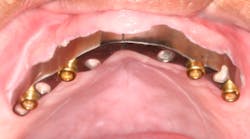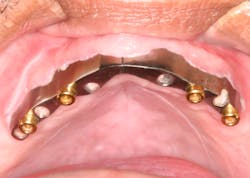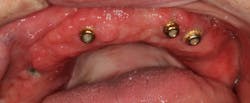Factors to consider when choosing between a bar versus a Locator implant overdenture
Which is the best method for implanting an overdenture? The clip bar or direct attachment method? The subject has been debated for years, and each method has its proponents. Steven Pigliacelli, MDT, CDT, examines several clinical scenarios and explains the deciding situational factors to consider between a bar and a Locator implant overdenture that will determine final case design.
THERE ARE SEVERAL METHODS of implanting an overdenture, but the two most widely used are the clip bar and direct attachment methods. A bar may be a Hader or Dolder bar that engages clips, or it may have Locator or ERA attachments that engage nylon inserts. A direct attachment may be a Locator, ERA, or a stud-type attachment.
Which of these two methods is superior? That subject has been debated for years. Each method has its own advocates with its own collection of research to support its position. Proponents of the clip bar method claim that a bar offers an evenly distributed force between dental implants, while supporters of direct attachments claim that this method is often cheaper and requires less vertical room. There is no easy answer. As with any dental prosthetic, the final case design is determined by the mouth itself.
Bar overdenture
Locator overdenture
A big misconception is that the denture is solely retained by the bar/attachments. This is not so. All overdentures must have support from both tissue and attachments. The denture rests on the soft tissue. The attachments act only as a lock, preventing the denture from dislodging. If there is no tissue support, the denture will not stay in.
Oftentimes, a degree of tissue recession, shrinkage, and resorption will occur within the first year after a denture is inserted. When this happens, greater force is placed on the attachment, creating a rock that will eventually cause the inserts to wear out. Each time this happens, the patient will be forced to return to the clinician’s office seeking new males for the dentures. Instead of repeated office visits, a definitive solution to this problem is a simple reline.
Let’s look at several different circumstances that will determine final case design.
A lower full denture on a patient with ideal ridge form can easily have two overdenture attachments placed to support the final denture. If the patient has a flat ridge, there will be no tissue support. All of the pressure will be on the attachment. If possible, a fixed case is better. A bar with horizontal lock attachments acts as a sort of fixed patient-removable prosthesis.
An upper denture may work with two attachments if the patient’s bite is an ideal Class I occlusion. If the patient has a severe overjet, a bar would be more desirable. If the denture is supported only by overdenture attachments, the denture will be tissue-supported everywhere except the anterior flange. When the patient bites, quite often the anterior flange can move. This causes a mesiodistal rock that puts all of the stress on the attachment. A bar can be extended past the ridge, preventing the anterior of the denture from making any movement. When the patient bites into an apple, for instance, the denture remains firm, and no stress is placed on retentive elements of the bar's attachments. If the patient bites into an apple without the bar, the whole denture may slide.
In short, whether the clip bar or direct attachment method is used for an overdenture implant depends on several situational factors, as well as the personal preferences of the clinician who places the implant. Neither method is inherently superior to the other. Both methods are valuable tools in the right situation.
📚ALSO BY THE AUTHOR ...
How to use an implant verification jig to ensure an accurate final framework every time
Correcting malpositioned dental implants: Where do we go from here?
The fall and rise of dental technology
The changing face of dentistry
Top 5 questions you should ask a dental lab before you send them a case



